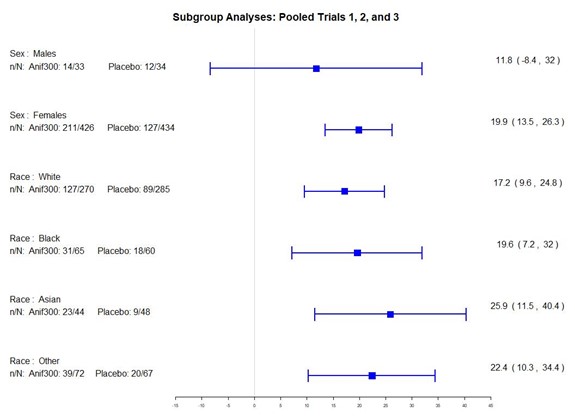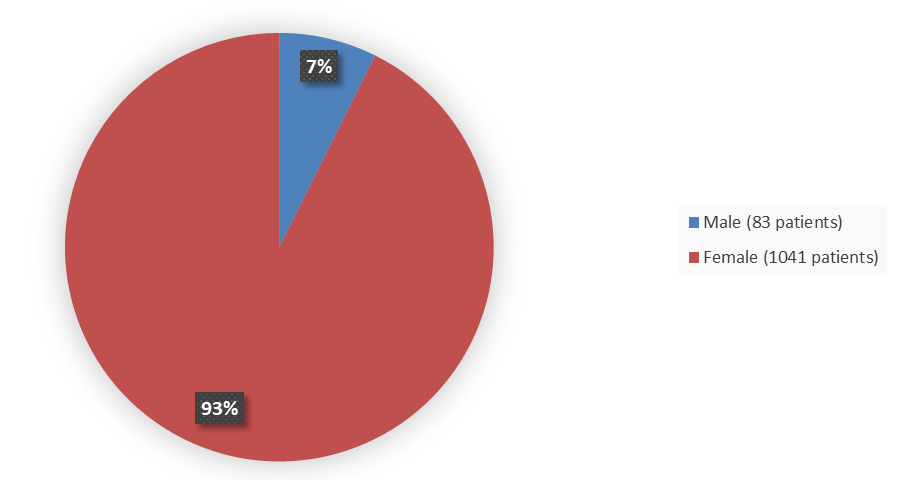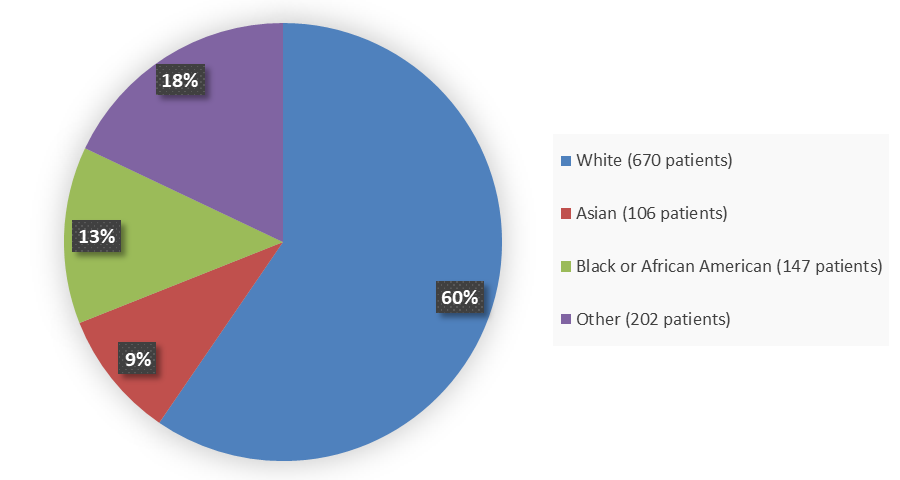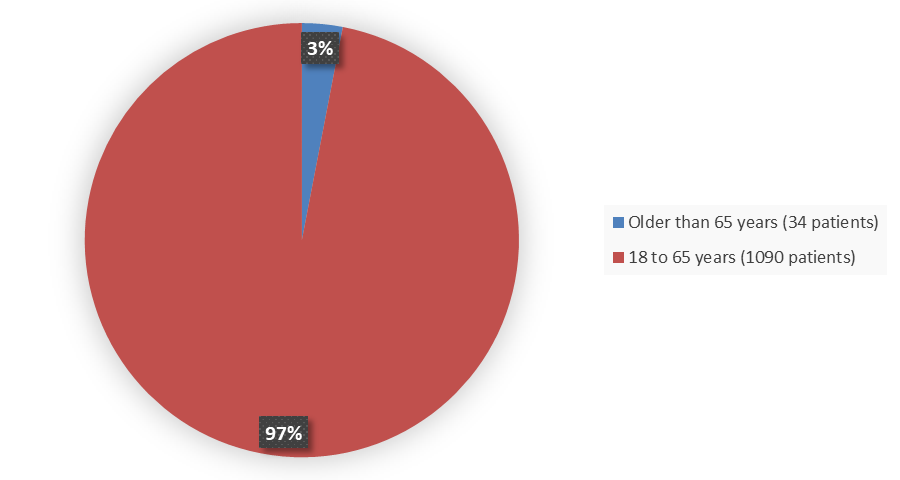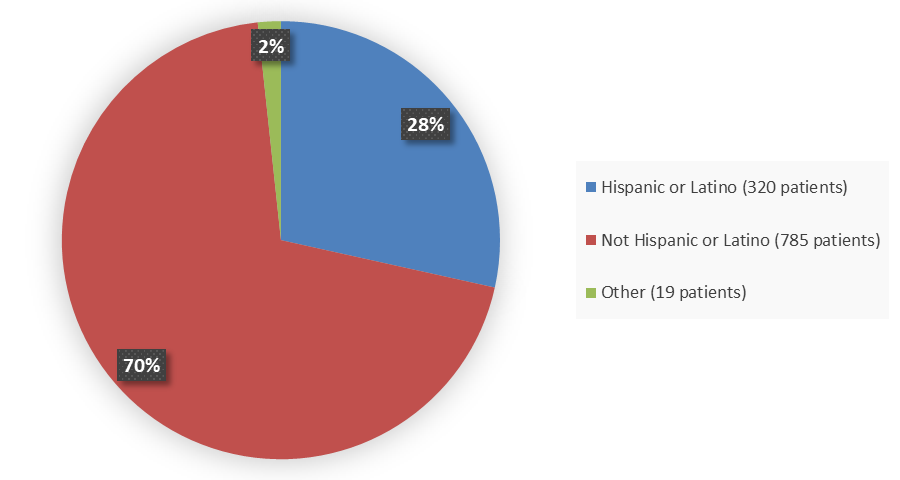Drug Trials Snapshots: SAPHNELO
HOW TO USE THIS SNAPSHOT
The information provided in Snapshots highlights who participated in the key clinical trials that supported the original FDA approval of this drug, and whether there were differences among sex, race, age, and ethnic groups. The “MORE INFO” bar shows more detailed, technical content for each section. The Snapshot is intended as one tool for consumers to use when discussing the risks and benefits of the drugs.
LIMITATIONS OF THIS SNAPSHOT
Do not rely on Snapshots to make decisions regarding medical care. Always speak to your healthcare provider about the benefits and risks of a drug.
Some of the information in this Snapshot is for presentation purposes and does not represent the approved conditions of use of this drug. Refer to the SAPHNELO Prescribing Information for all of the approved conditions of use of this drug (e.g., indication(s), population(s), dosing regimen(s), safety information).
Snapshots are limited to the information available at the time of the original approval of the drug and do not provide information on who participated in clinical trials that supported later approvals for additional uses of the drug (if applicable).
SAPHNELO (anifrolumab-fnia)
(saf ne’loe)
AstraZeneca AB
Approval date: July 30, 2021
DRUG TRIALS SNAPSHOT SUMMARY:
What is the drug for?
SAPHNELO is a drug used in adults to treat moderate to severe systemic lupus erythematosus (SLE).
SLE is a chronic autoimmune disease where the body’s immune system attacks its own tissues that can cause damage to joints, skin, brain, lungs, kidneys, and blood vessels.
How is this drug used?
SAPHNELO is given by a healthcare provider using a needle placed in a vein (known as intravenous infusion) every 4 weeks.
Who participated in the clinical trials?
The FDA approved SAPHNELO based on evidence on efficacy and safety from three clinical trials (Trial 1/NCT01438489, Trial 2/NCT02446912, and Trial 3/NCT02446899) of 1,124 patients with systemic lupus erythematosus. The trials were conducted at 219 sites in 28 countries in all 5 regions (39% in USA/Canada, 16% in Latin America, 33% in Europe, 9% in the Asia-Pacific region, and 3% in the rest of the world).
What are the benefits of this drug?
In the clinical trials, a greater proportion of patients who received SAPHNELO for one year achieved an improvement in the signs and symptoms of SLE in comparison to patients who received placebo.
What are the benefits of this drug (results of trials used to assess efficacy)?
Table 1 below summarizes the efficacy results for individual trials 1, 2, and 3. Efficacy was assessed by comparing the proportion of patients who achieved BICLA response at Week 52 between SAPHNELO and placebo.
Table 1. Summary of Efficacy Results
| Parameter | Trial 1 | Trial 2 | Trial 3 | |||
|---|---|---|---|---|---|---|
| SAPHNELO 300 mg N=99 |
Placebo N=102 |
SAPHNELO 300 mg N=180 |
Placebo N=184 |
SAPHNELO 300 mg N=180 |
Placebo N=182 |
|
| BICLA response rate | ||||||
| Responder, n (%) | 54 (54.6) | 27 (25.8) | 85 (47.1) | 55 (30.2) | 86 (47.8) | 57 (31.5) |
| Difference in response rates (95% CI) | 28.8 (15.7, 41.9) | 17.0 (7.2, 26.8) | 16.3 (6.3, 26.3) p-value=0.001 |
|||
| Components of BICLA response | ||||||
| SLEDAI-2K improvement, n (%) | 54 (54.5) | 28 (27.5) | 85 (47.2) | 58 (31.5) | 88 (48.9) | 59 (32.4) |
| No worsening of BILAG, n (%) | 73 (73.7) | 61 (59.8) | 121 (67.2) | 104 (56.5) | 122 (67.8) | 94 (51.6) |
| No worsening of PGA, n (%) | 76 (76.8) | 62 (60.8) | 117 (65.0) | 105 (57.1) | 122 (67.8) | 95 (52.2) |
Source: Adapted from FDA Review
Reported percentages for BICLA response rate are adjusted
Reported percentages of components are unadjusted
Abbreviations: BICLA, British Isles Lupus Assessment Group–based Composite Lupus Assessment; BILAG, British Isles Lupus Assessment Group; PGA, physician global assessment; SLEDAI-2K, Systemic Lupus Erythematosus Disease Activity Index 2000
Were there any differences in how well the drug worked in clinical trials among sex, race and age?
- Sex: SAPHNELO worked better in females than in males, however, the sample size of males was small.
- Race: SAPHNELO worked similarly in White and Black or African American patients. SAPHNELO worked better in Asian and Other race categories; however, the sample sizes were small for subgroups of races other than White.
- Age: The difference in how well SAPHNELO worked could not be determined in patients below and above 65 years of age, since the number of patients above 65 was very small.
Were there any differences in how well the drug worked in clinical trials among sex, race, and age groups?
Figure 1 below shows the subgroup results, based on shrinkage analyses, for sex and race from the pooled results of Trials 1, 2, and 3. Most patients were younger than 65 years of age, therefore, the analysis by age was not performed.
Figure 1. Subgroup Analyses: Pooled Trials 1, 2, and 3
What are the possible side effects?
SAPHNELO may cause serious side effects including increased risk of developing serious and sometimes fatal infection, respiratory infection, herpes zoster infection (shingles), infusion related reaction, and increased risk of developing cancer.
The most common side effects are runny nose, upper respiratory tract infection, bronchitis, infusion related reactions, herpes zoster (shingles), and cough.
What are the possible side effects (results of trials used to assess safety)?
Table 2. Adverse Reactions Occurring in ≥2% of Patients on SAPHNELO 300 mg (Trials 1, 2, and 3) at 52 Weeks
| Adverse Reaction | SAPHNELO N=459 % |
Placebo N=466 % |
|---|---|---|
| Upper respiratory tract infection* | 34 | 23 |
| Bronchitis† | 11 | 5.2 |
| Infusion-related reactions | 9.4 | 7.1 |
| Herpes zoster | 6.1 | 1.3 |
| Cough | 5.0 | 3.2 |
| Respiratory tract infectionǂ | 3.3 | 1.5 |
| Hypersensitivity | 2.8 | 0.6 |
Source: Adapted from FDA Review
All patients received standard therapy
* Upper respiratory tract infections (including Upper respiratory tract infections, Nasopharyngitis, Pharyngitis)
† Bronchitis (including Bronchitis, Bronchitis viral, Tracheobronchitis)
ǂ Respiratory tract infection (including Respiratory tract infection, Respiratory tract infection viral, Respiratory tract infection bacterial)
Were there any differences in side effects among sex, race and age?
- Sex: The majority of patients were female. The differences in side effects between males and females were not analyzed.
- Race: The occurrence of side effects was similar in White and Black or African American patients.
- Age: The majority of patients were younger than 65 years of age, therefore the differences in side effects between younger and older patients could not be determined.
Were there any differences in side effects of the clinical trials among sex, race, and age groups?
Table 3 below summarizes the occurrence of adverse events by race subgroups in the Phase 3 studies. Sex and age subgroups were not analyzed because the majority of patients were female and younger than 65 years of age.
Table 3. Subgroup Analysis of Treatment-Emergent Adverse Events by Race (Trials 2 and 3)
| Adverse Event | White | Asian | Black or African American | Other | ||||
|---|---|---|---|---|---|---|---|---|
| SAPHNELO | Placebo | SAPHNELO | Placebo | SAPHNELO | Placebo | SAPHNELO | Placebo | |
| Any TEAE, n/N (%) | 204/235 (86.8%) | 186/243 (76.5%) | 38/41 (92.7%) | 35/35 (100%) | 40/46 (87.0%) | 39/48 (81.3%) | 28/30 (93.3%) | 27/31 (87.1%) |
| Any serious TEAE, n/N (%) | 27/235 (11.5%) | 35/243 (14.4%) | 4/41 (9.8%) |
8/35 (22.9%) | 4/46 (8.7%) |
12/48 (25%) | 3/30 (10%) |
5/31 (16.1%) |
Source: Adapted from FDA Review
Abbreviations: TEAE, treatment-emergent adverse event
DEMOGRAPHICS SNAPSHOT
Figure 2 summarizes how many male and female patients were enrolled in the clinical trials.
Figure 2. Baseline Demographics by Sex
Source: Adapted from FDA Review
Figure 3 summarizes the percentage of patients by race enrolled in the clinical trials.
Figure 3. Baseline Demographics by Race
Source: Adapted from FDA Review
Figure 4 summarizes the percentage of patients by age in the clinical trials.
Figure 4. Baseline Demographics by Age
Source: Adapted from FDA Review
Figure 5 summarizes the percentage of patients by ethnicity in the clinical trials.
Figure 5. Baseline Demographics by Ethnicity
Source: Adapted from FDA Review
Who participated in the trials?
Table 4. Trial Demographics (Safety Population)
| Parameter | SAPHNELO 300 mg N=459 |
Placebo N=466 |
TOTAL N=925 |
|---|---|---|---|
| Sex, n (%) | |||
| Female | 426 (92.8) | 432 (92.7) | 858 (92.8) |
| Male | 33 (7.2) | 34 (7.3) | 34 (7.3) |
| Race, n (%) | |||
| Asian | 44 (9.6) | 48 (10.3) | 92 (9.9) |
| American Indian or Alaska Native | 8 (1.7) | 8 (1.7) | 16 (1.7) |
| Black or African American | 65 (14.2) | 59 (12.7) | 124 (13.4) |
| Other | 64 (13.9) | 65 (13.9) | 129 (13.9) |
| White | 270 (58.8) | 284 (60.9) | 554 (59.9) |
| Age, median (min, max) | 41 (18, 69) | 41 (18, 69) | 41 (18, 69) |
| Age group, n (%) | |||
| 18 to <65 years | 442 (96.3) | 457 (98.1) | 899 (97.2) |
| ≥65 years | 17 (3.7) | 9 (1.9) | 26 (2.8) |
| Ethnicity, n (%) | |||
| Hispanic or Latino | 132 (28.8) | 131 (28.1) | 263 (28.4) |
| Not Hispanic or Latino | 319 (69.5) | 327 (70.2) | 646 (69.8) |
| Unknown | 8 (1.7) | 8 (1.7) | 16 (1.7) |
| Geographic region, n (%) | |||
| Asia-Pacific | 41 (8.9) | 44 (9.4) | 85 (9.2) |
| Europe | 135 (29.4) | 147 (31.5) | 282 (30.5) |
| Latin America | 98 (21.4) | 94 (20.2) | 192 (20.8) |
| USA/Canada | 176 (38.3) | 166 (35.6) | 342 (37.0) |
| Rest of world | 9 (2.0) | 15 (3.2) | 24 (2.6) |
Source: Adapted from FDA Review
How were the trials designed?
The benefit and side effects of SAPHNELO were evaluated in three clinical trials which enrolled adult patients with systemic lupus erythematosus (SLE) with active disease despite taking medicines to treat their condition. SLE patients with severe kidney disease or severe central nervous system disease were not included in these studies.
Patients received an infusion of either SAPHNELO or inactive control every 4 weeks for up to a year. Neither the patients nor the health care providers knew which treatment was being given until after the trial was completed.
The benefit of SAPHNELO in comparison to control was assessed after 12 months by comparing the percentage of patients who had reduction in SLE disease activity and who did not require significant changes to their baseline SLE medications.
How were the trials designed?
There were three trials that provided data for SAPHNELO approval in SLE adult patients with moderate to severe disease despite receiving standard therapy. Patients were diagnosed with SLE according to the American College of Rheumatology (1982 revised) classification criteria. All patients were ≥18 years of age and had moderate to severe disease, with a SLE Disease Activity Index 2000 (SLEDAI-2K) score ≥6 points, organ level involvement based on BILAG assessment, and a Physician’s Global Assessment (PGA) score ≥1, despite receiving standard SLE therapy consisting of either one or any combination of oral corticosteroids (OCS), antimalarials and/or immunosuppressants at baseline.
The safety and efficacy of SAPHNELO were evaluated in three 52-week treatment period, multicenter, randomized, double-blind, placebo-controlled studies (Trial 1/NCT01438489, Trial 2/NCT02446912 and Trial 3/NCT02446899). Patients continued to receive their existing SLE therapy at stable doses during the clinical trials, with the exception of prednisone (or equivalent) where tapering was a component of the protocol. Patients who had severe active lupus nephritis and patients who had severe active central nervous system lupus were excluded. The use of other biologic agents and cyclophosphamide were not permitted during the trials.
Efficacy of SAPHNELO was established based on assessment of clinical response using the composite endpoints: the British Isles Lupus Assessment Group (BILAG)-based Composite Lupus Assessment (BICLA) and the SLE Responder Index (SRI-4).
BICLA response at Week 52 was defined as improvement in all organ domains with moderate or severe activity at baseline per the following criteria:
- Reduction of all baseline BILAG A to B/C/D and baseline BILAG B to C/D, and no BILAG worsening in other organ systems, as defined by ≥1 new BILAG A or ≥2 new BILAG B;
- No worsening from baseline in SLEDAI-2K, where worsening is defined as an increase from baseline of >0 points in SLEDAI-2K;
- No worsening from baseline in patients’ lupus disease activity, where worsening is defined by an increase ≥0.30 points on a 3-point PGA visual analogue scale (VAS);
- No discontinuation of treatment;
- No use of restricted medication beyond the protocol-allowed threshold.
SRI-4 response was defined as meeting each of the following criteria at Week 52 compared with baseline:
- Reduction from baseline of ≥4 points in the SLEDAI-2K;
- No new organ system affected as defined by 1 or more BILAG A or 2 or more BILAG B items compared to baseline;
- No worsening from baseline in the patients’ lupus disease activity defined by an increase ≥0.30 points on a 3-point PGA VAS;
- No discontinuation of treatment;
- No use of restricted medication beyond the protocol-allowed threshold.
Trial 1 randomized 305 patients (1:1:1) who received SAPHNELO, 300 mg or 1000 mg, or placebo for up to 52 weeks. The primary endpoint was a combined assessment of the SRI-4 and the sustained reduction in daily prednisone (or prednisone equivalent) measured at Week 24, and a key secondary endpoint was BICLA at Week 52
Trials 2 and 3 were similar in design. Trial 2 randomized 457 patients who received SAPHNELO, 150 mg or 300 mg, or placebo (1:2:2). Trial 3 randomized 362 patients (1:1) who received SAPHNELO 300 mg or placebo. The primary endpoints were improvement in disease activity evaluated at 52 weeks, measured by SRI-4 in Trial 2 and BICLA in Trial 3.
Data from all three trials were used for safety assessment.
GLOSSARY
CLINICAL TRIAL: Voluntary research studies conducted in people and designed to answer specific questions about the safety or effectiveness of drugs, vaccines, other therapies, or new ways of using existing treatments.
COMPARATOR: A previously available treatment or placebo used in clinical trials that is compared to the actual drug being tested.
EFFICACY: How well the drug achieves the desired response when it is taken as described in a controlled clinical setting, such as during a clinical trial.
PLACEBO: An inactive substance or “sugar pill” that looks the same as, and is given the same way as, an active drug or treatment being tested. The effects of the active drug or treatment are compared to the effects of the placebo.
SUBGROUP: A subset of the population studied in a clinical trial. Demographic subsets include sex, race, and age groups.
PRESCRIBING INFORMATION

